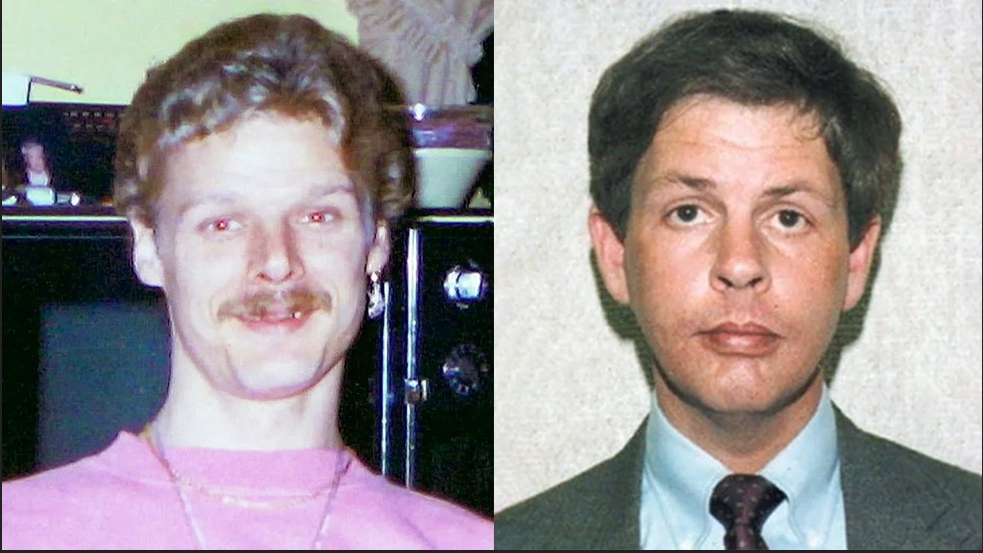
Indiana authorities announced they have positively identified another presumed victim of Herbert Baumeister, (right) the wealthy Republican businessman, husband, and father who was suspected of killing over 20 boys and young men he met at or around gay bars during the 1980s and ’90s. On Tuesday, Hamilton County Coroner Jeff Jellison revealed that a DNA sample found on Baumeister’s estate was identified as Allen Livingston, (left) a gay man who went missing in 1993 at the age of 27. Photos: Provided by Allen Livingston’s family via WTHR 13 News and the Indianapolis Police Department
Indiana authorities announced they have positively identified another presumed victim of Herbert Baumeister, the wealthy Republican businessman, husband, and father who was suspected of killing more 20 boys and young men he met at or near gay bars during the 1980s and ’90s.
Baumeister shot and killed himself in 1996 at a public park in Canada after police searched his 18-acre Fox Hollow Farm estate in Westfield, outside of Indianapolis, and issued a search warrant for his arrest.
Investigators eventually recovered more than 10,000 crushed and charred bone fragments from Baumeister’s estate. During the initial investigation, officials extracted 11 human DNA samples, of which eight, all young men, were identified and matched.
A renewed effort started last year that resulted in two new genetic profiles being identified.
On Tuesday, Hamilton County Coroner Jeff Jellison said one of those profiles belonged to Allen Livingston, 27, a gay man who went missing in 1993, the Associated Press reported. Livingston is the ninth positively identified presumed victim of Herbert Baumeister, although authorities believe he may have killed up to 25 men and boys.
A swab from Livingston’s mother was used to identify her son.
Jellison credits the renewed identification efforts to a phone call he received last year from a cousin of Allen. The cousin said the family firmly believed his remains were amongst those found on the property.
He also said the family wanted to provide closure to Livingston’s mother who is in poor health.
Jellison called Livingston’s mother on Monday to deliver the news.
“Yesterday was an emotional day in our office,” Jellison told the AP. “We identified a person who had been missing for 30 years. That person is likely a murder victim. So our first reaction was to celebrate the success of what we had done, but we very quickly turned to the stark reality that we’ve got another murder victim.”
According to investigators, Herbert Baumeister was leading a deadly double life. While he appeared to be a loving husband and father and a successful businessman, he is suspected of cruising local gay bars for young men he lured to his estate and strangled to death.
Police also believe Baumeister was the I-70 strangler, a serial killer who killed 11 young men and boys and dumped their bodies throughout Indiana and Ohio between June 1980 and October 1991.
Investigators noted the discovery of bodies from the I-70 Strangler stopped when Baumeister bought his estate in Fox Hollow Farm, leading them to believe he continued killing, but used the estate as his new dumping ground.
In 1994, Herbert Baumeister’s 13-year-old son Erich found a human skull and a collection of bones while playing on the family’s Fox Hollow Farms estate. According to a 1996 interview with People, Baumeister’s wife Julia said her husband explained the bones were from an old medical skeleton used by his late father, an anesthesiologist.
She also revealed that the couple had engaged in sexual intercourse only three times in their marriage, and that she had never seen him fully naked.
The couple ran the successful Sav-A-Lot chain of stores, allowing them to move into the exclusive Fox Hollow Farms.
Julie said she forgot about the incident until November 1995 when police asked permission to search the property as part of their investigation into a string of killings targeting young gay men in the area.
Police said a young man had identified Baumeister as the man who had suffocated him to the brink of death during a sexual tryst at the estate. The Baumeisters refused the request, but Julie later consented while Herbert was out of town in June 1996.
Herbert’s body was found with a single gunshot wound to the head on July 3, 1996, at a public park in Ontario, Canada.
Jellison revealed that the recent investigation selected 44 remains for genetic testing. He is still astounded that Livingston’s were the first to be positively matched.
“What are the odds, out of 10,000 remains? Out of 10,000, we selected 44 and the first identification is a person from the family that initiated this whole thing,” Jellison said Tuesday. “Where does that come from?”
Jellison said four other DNA profiles have been identified, and they were comparing those against DNA samples received from more than 30 families of missing men who may also be victims of Baumeister.
